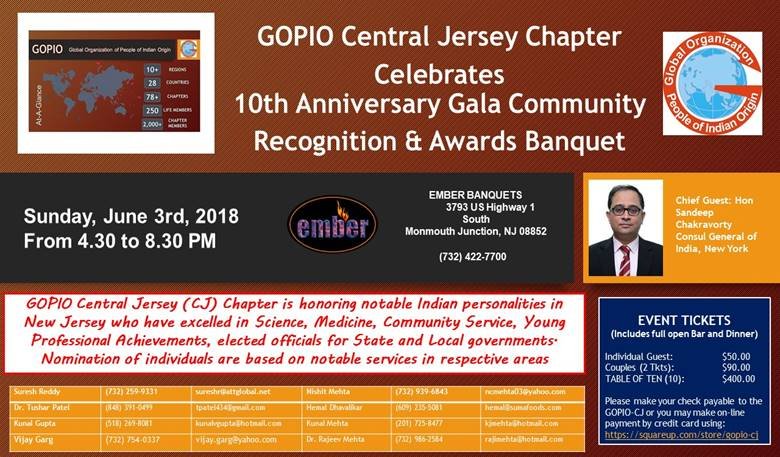America
Announcing GOPIO-Central Jersey 10th Anniversary, Seeking Award Nominations and GOPIO-CT Appeal to support MISSION 12 NASA TEAM PROJECT
Dear Indian Community Members in New Jersey:
GOPIO-Central Jersey is pleased to announce the 10th Anniversary Celebrations with a Gala Banquet and Award Ceremony to be held on Sunday, June 3rd starting at 4.30 p.m. at Ember Banquets, Monmouth Junction, New jersey. As part of the celebration we will honor those achievers in different fields (Basic or Applied Science, Social Sciences, Arts and Letters, Performing Arts, Education, Engineering and Technology, Entrepreneurship/Business, Corporate Management, Medicine and Health Services, Journalism and Mass Communication, Community Service) from Indian American community residing in New Jersey. Please block your calendar for that day.
We seek nominations from Indian American residents in New Jersey who are outstanding achievers and/or those who have made notable contributions to the society or provided community service. We are also seeking nominations for a “Friend of India Award†to be presented to an American (non-PIO) who has done outstanding work in promoting the Indian community in the US or in furthering Indo-American relations. An young Indian American (age below 35) will also be recognized at the banquet.
Attached herewith is the nomination form. Please send in nominations of any achievers residing in New Jersey right away, but not later than April 15, 2018 to [email protected].
GOPIO-Central Jersey is also seeking sponsors for the banquet and advertisers in program booklet. More details are attached. You may contact GOPIO-Central Jersey President Suresh Reddy at 732-259-9331, or e-mail: [email protected].
Thank you.
Dinesh Mittal
Chairman, Awards Committee
GOPIO-Central Jersey
Tel: 908-705-6365
E-mail: [email protected]
APPEAL FROM GOPIO-CT
Dear all,
We are very excited to announce that an Indian American Youth team, Mission 12 from Stamford, Connecticut, has been chosen to compete in the Student Spaceflight Experiments Program. The team consist of many Indian American students. This NASA sponsored competition allows students to propose and design experiments, to be conducted aboard the International Space Station (ISS).
This is a very proud moment for Indian Americans!
Mission 12 team has been working relentlessly to reach their goal of raising funds to take part in the competition. They have not met their target of raising $22,0000. We cannot let our youth miss this great opportunity. We are sending the information on their research below. Please read and donate generously to support our youth. Donations can sent as follows:
GOFUNDME Page
https://www.gofundme.com/Nasastudents
Thank you for your support.
Yours Sincerely,
Anita Bhat
President, GOPIO-CT
Stamford, CT
MISSION 12 NASA TEAM PROJECT?
Statement:
Stamford High School’s Mission 12 NASA team is extremely excited to inform you that during this school year, we students of Stamford High School were offered a once in a life time opportunity: to compete in the Student Spaceflight Experiments Program. This NASA sponsored competition allows students to propose and design experiments, to be conducted aboard the International Space Station(ISS). Out of hundreds of submissions from high schools and universities alike, Stamford High's submission was selected as a winning proposal and is destined to travel beyond Earth.
Our mission seeks to analyze the effect of microgravity on the reproduction of the fungus Sordaria fimicola. In a reproductive cycle, this fungus undergoes meiosis and mitosis. Meiosis is the sexual process in which cells reproduce and crossing over is vital to achieve greater genetic variation. Crossing over is a process that occurs in meiosis that involves the exchange of chromosome segments between two homologous chromosomes. With a wider variety of offspring produced, the species is more likely to adapt to environmental changes. Our experiment analyzes the effect that gravity has on crossing over. To measure crossing over, our experiment breeds together two strains of the fungus. When Sordaria fimicola breeds, it creates ascii containing eight ascospores in each, and the arrangement of the colored ascospores can indicate whether crossing over has occurred successfully. Another aspect that is visible is whether a mutation has occurred. There are expected to be eight ascospores, four of each color, as a result of successful crossing over of the chromosomes. If one of these conditions isn’t met, it becomes evident that a mutation has occurred. These two individual factors show scientists how prepared organisms are for the vast emptiness of space along with arming them with the knowledge to tackle these problems should they appear. The results found will provide further insight into not just the viability of long term human habitation of space, but also the potential of extraterrestrial life at large.
Our justification to explore the concept of genetic mutation and variations in fungus was provided by our interest in a current ongoing study by NASA’s Human Research Program, called NASA Twin Study. The study focuses on four categories of research split into 10 investigations to evaluate identical twin astronauts Scott and Mark Kelly. These investigations provide broader insight into the subtle effects and changes that may occur in spaceflight as compared to Earth. This is done by studying two individuals who have the same genetics, but are in different environments for one year. Just recently, exciting news was uncovered that after Scott Kelly spent 340 days on board the ISS, investigators found that 7% of his genes no longer matched those of brother Mark. Though the variation is ever so small, scientists are becoming increasingly intrigued to study the effects of microgravity on genetic mutation. That’s where our interest stems from. As discussion about colonizing planets like Mars in the future is becoming a major topic discussion, we asked the question: Will life grow and interact the same way as it has been on Earth for millions of years?
Over the last couple of months since the selection and confirmation from important organizations such as NASA, NCESSE (National Center for Earth and Space Science Education) and NanoRacks that our experiment is viable for spaceflight and experimentation aboard the International Space Station, we have since been receiving many generous opportunities such as presenting our experiment at the University of Bridgeport Science Symposium in March, and receiving the honor and invitation to attend a conference at the Smithsonian National Air and Space Museum in Washington, DC in late June.
With the money you so charitably donate, we hope to travel to the Smithsonian National Air and Space Museum this July where we will present our tangible results to a conference of all teams whose proposals were selected for Spaceflight. Dependent on the generosity of you reader, we might also travel to see the launch of the SpaceX Falcon 9 rocket which will carry our experiment to the ISS this spring. Currently the Mission 12 Stamford High School Team has raised over $7,000 out of our $22,000 milestone, and we are still relentlessly reaching out to various organizations and communities for generous support.
?
We are inexpressibly grateful to our teachers, parents, community, and most certainly our donors who have allowed us to shoot for the stars.
Below, there are links to media coverage and our GoFundMe page:
Stamford Advocate Newspaper Coverage
https://www.stamfordadvocate.com/local/article/Stamford-High-students-yeast-experiment-wins-12617510.php
New 12 Connecticut Coverage
https://app.criticalmention.com/app/#clip/view/32674614?token=d47267c3-ef0a-4559-9775-9b07402bfacc
GOFUNDME Page
https://www.gofundme.com/Nasastudents
Thanks in advance for your help and support.
Mission 12 Team


























